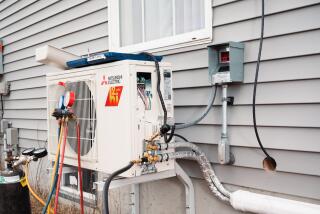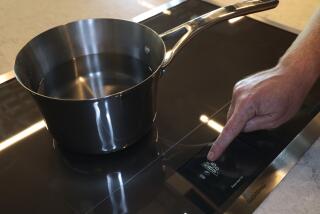Shrink your energy footprint
- Share via
The average American home contains 25 consumer electronics devices. So to go green, start with what you’ve got.
First, get a handle on your current electricity usage. A device called Kill A Watt, from P3 International Corp., makes for a nifty parlor game of Guess Watt with anything that plugs into a socket.
One surprise might be how much energy some devices use even when idle or turned off. Consumer electronics suck as much as 25% of their power when not in use, according to the U.S. Department of Energy. For computers, the figure can be much higher -- up to 85% for a PC that’s always left on.
That’s because many devices don’t really turn off -- they operate in standby mode, awaiting commands from a remote control. Many also have digital displays that stay on.
For example, a computer, monitor and cable modem together suck 11 watts even when powered down, adding 66 cents to a typical Californian’s monthly energy bill. An idle CD player can munch 6 watts. So can a switched-off TV.
It adds up. These silent siphons of energy, known as phantom loads, add about $28 to the average annual household power bill, according to the energy department.
You can tame these electricity vampires by unplugging devices between uses. If that’s too much effort, consider buying a SmartStrip, a power strip and surge protector that automatically cuts off power to devices that are shut down.
It’s designed to be used with computers or home entertainment systems where devices operate in clusters. If, for example, the TV is off, the SmartStrip also shuts down the DVD player, surround-sound speakers and cable box.
What about cellphones, digital cameras, iPods and other rechargeable devices? Try taking them off the grid, at least partially. A Solio charger, about the size of a computer mouse, attaches with a suction cup to a window, where it soaks up enough energy from the sun to fully power up two cellphones.
For those on the move, there’s a solar backpack from Voltaic Systems Inc. Fully charged, the backpack’s solar panels can juice up to three iPods. The company is expected to come out this spring with a version powerful enough to charge laptops.
Wind power is another alternative. The 5-inch HYmini wind turbine attaches to your arm while running, downhill skiing or biking. A 20-minute session with wind speeds of 19 mph can capture enough power to keep an iPod going for 30 minutes, according to Miniwiz, the Taiwanese company that makes HYmini.
Alternative energy isn’t always the cheapest or fastest way to charge up. The Solio costs $80 to $200. The solar backpacks are $199 to $599. And the HYmini is $50 to $70. Most take hours of movement or sunbathing to fully charge.
A more economical and easier tweak is to reduce battery usage, which might help cut down on the 15 billion disposable batteries produced each year.
A top-of-the-line AA nickel metal hydride MaxE battery from Ansmann Energy, distributed in the U.S. by Horizon Battery, costs about $4 and can be recharged 1,000 times. At 3 cents in electricity per charge, the battery’s total cost comes to about $34. By contrast, 1,000 disposable AA batteries costing 30 cents apiece would cost about $300.
Road warriors who don’t want to get loaded down with a charging unit might consider USBCell, which looks and acts just like a AA battery, except the top pops off to reveal a USB head that can plug into a laptop’s USB port to recharge. A pair will set you back $17.50.
More to Read
Inside the business of entertainment
The Wide Shot brings you news, analysis and insights on everything from streaming wars to production — and what it all means for the future.
You may occasionally receive promotional content from the Los Angeles Times.










